28 awesome day trips to take from Sevilla
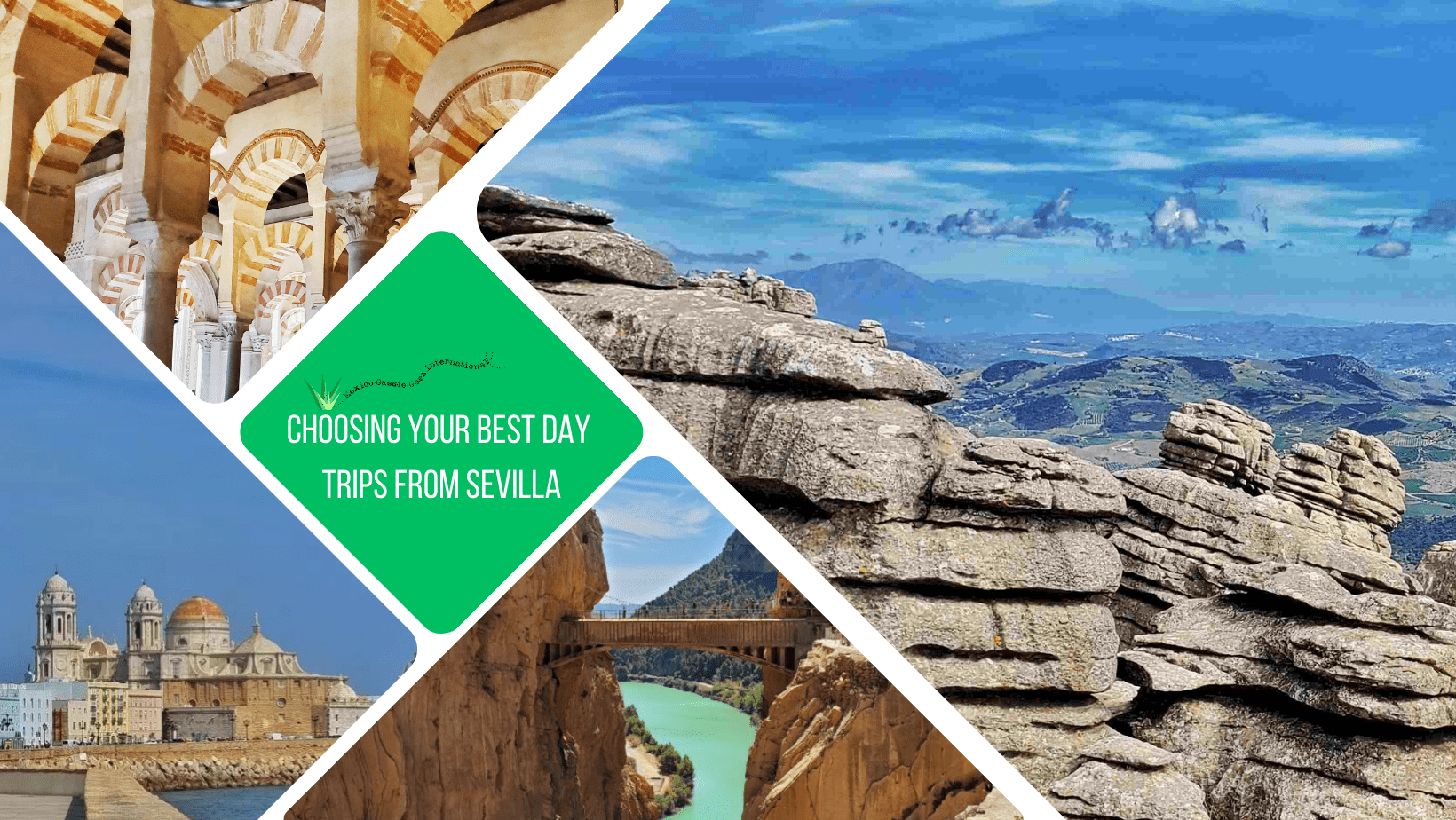
Seville is a marvellous city to visit and explore. It’s also a really great base for exploring around Andalucía.
If you’re lucky enough to have more than 3 days in Seville then you’re likely to be thinking about taking a day trip or two. In this article you’ll read about not only the “big name attractions” but also lesser known day trips from Sevilla that are truly excellent for anyone who has already seen the ‘big 4’ or who wants to avoid crowds.
Whether you’re looking to explore UNESCO World Heritage Sites, have lunch in tiny white villages (pueblos blancos), see Roman ruins, go hiking or chill on the beach, it’s all achievable with a day trip from Sevilla.
There are affiliate links in this article. If you click and make a purchase I could make a small sum at zero cost to you. Thank you!
Day trip transport options
🗺 As you probably know, Seville is the capital city of Seville Province. Seville Province is one of 8 provinces in the Autonomous Community of Andalucía. If you’re not planning on road tripping then you’re unlikely to get as far as Jaén or Almería Provinces but the other provinces: Cádiz, Córdoba, Huelva, Málaga & Granada are all possible to visit on day trips from Seville. I know, because I’ve taken day trips from Seville, to all of these places, multiple times.
🥇 For every day trip below I highlight which forms of transport are easy / possible to help guide your planning of day trips from Sevilla.
Driving from Seville
🚗 The roads in southern Spain are well maintained, particularly the highways (autovías). Renting a car and driving myself is far and away my preference when exploring a new place. I love the freedom it brings to change plans, get excited about a castle on a hill or a cute restaurant or to detour to see an amazing view. I love not being constrained by timetables.
🅿️ City roads and small town/village roads can be very narrow in Spain so if you do choose to drive, my biggest tip is to try not to get yourself caught up in a maze of narrow streets because it’s not fun. Instead, plan where you’re going to park before you set off for your adventure.
Public transport from Seville
Sevilla has good public transport links to big cities and to some of the smaller towns too.
Train
🚂 The main train station in Sevilla is called Santa Justa Station.
It is recommended to book all train travel as much in advance as possible. My favourite place to book train tickets is Trainline because it covers all companies accurately, saving you the need to check and compare on numerous sites.
→ Check train tickets and timetables on Trainline
Bus
🚌 Long distance buses leave from the main bus station, Plaza de Armas. There are numerous bus companies serving Andalucía so I like to use Busbud to check timetables and book my buses.
→ Check bus timetables, locations and prices on Busbud.
Guided tour
👣 Taking a tour is a great way to see a lot in a short space of time. It’s also perfect if you really don’t fancy figuring out public transport in a foreign country.
→ Check Viator and GetYourGuide to see what tours are available and I’ll add links to my recommended tours where I have them.
Most popular day trips from Sevilla
The following are the most popular day trips from Sevilla. For people who haven’t been to this region before, these are the most common destination because they’re the truly ‘big ticket’ items and they are, without a doubt, fabulous.
Córdoba and the Mezquita | Granada and the Alhambra | Cádiz | Ronda
🎟 The most important thing to know is that if you’re planning on visiting the Mezquita or the Alhambra, like Sevilla’s Alcazar, is that you must book your tickets in advance. While you may manage to get a ticket on the day, you also may waste time waiting in line or even find there are no tickets left at all, which just isn’t a risk worth taking.
Córdoba and the Mezquita
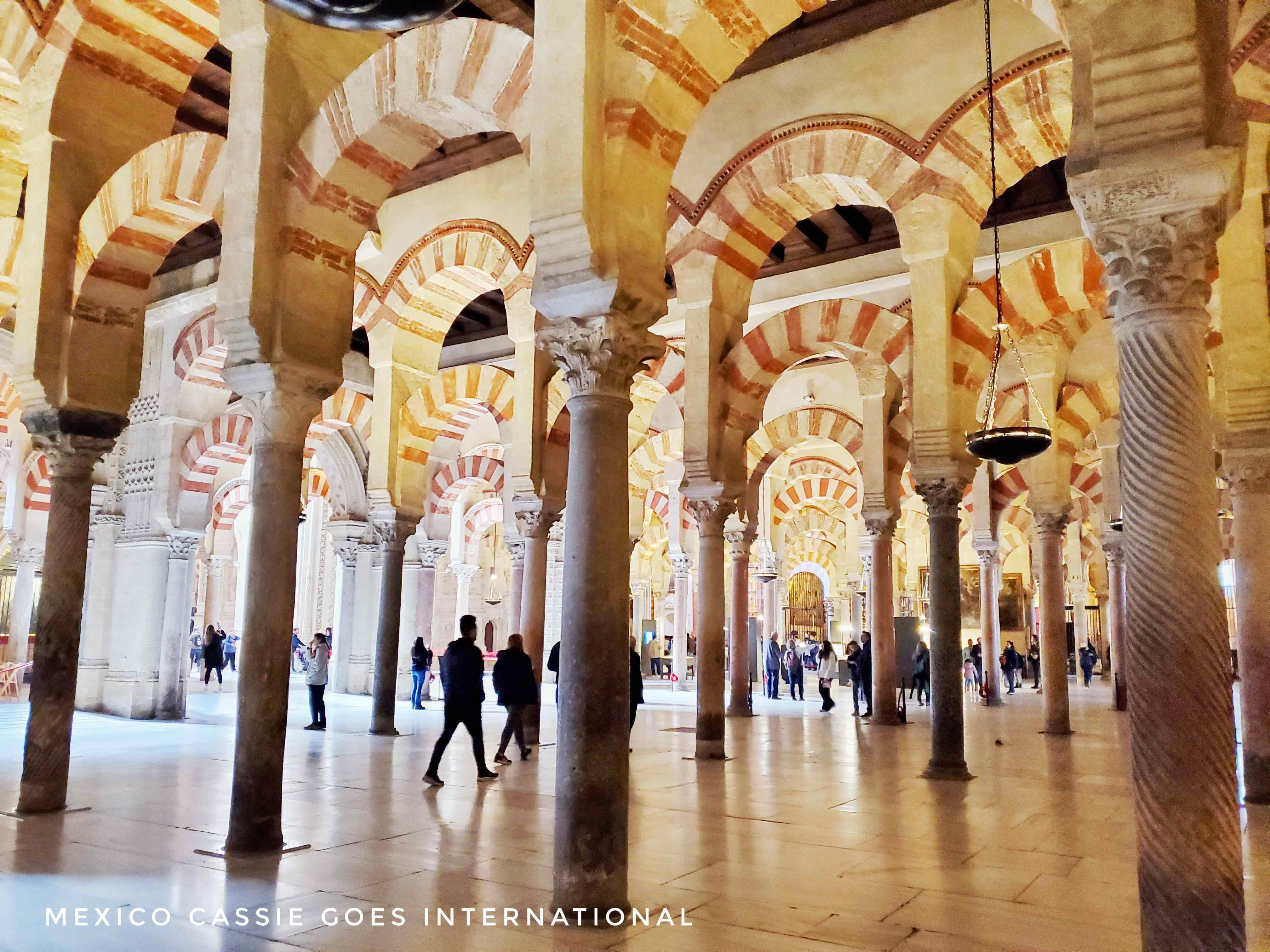
Cordoba is an incredibly beautiful city but of course most people who just visit Córdoba for one day head straight to the most famous, the Mesquita, Córdoba’s mosque-cathedral, UNESCO world heritage site.
🔎 Under Roman rule Córdoba was an important commercial centre and seat of learning and culture for the whole Roman empire. The city was captured by the Moors in 711 CE and flourished as their capital on the peninsula. In 1236, Fernando III captured Córdoba and after that, according to local (Christian) history, Christians, Muslims and Jews lived peacefully side-by-side. Non-Christian history does not paint quite such a rosy version of events.
🎟 Book your tickets for the Mezquita
→ On the official Mezquita site
→ On the Tiqets website
→ Book a tour of the Mezquita
What else can you do in Córdoba
🔔 The Bell Tower -tThe Mezquita bell tower has limited tickets every day Try to reserve tickets as the views from the top are well worth it. Avoid long lines and buy tickets in advance online.
🗼Torre de la Calahorra and the Museum of Al-Andalus – this small museum is directly across the Roman Bridge from the Mezquita.
🏰 Alcázar de los Reyes Cristianos – a UNESCO World Heritage fortress-palace built in the 14th century.
🪨 Archaeological Museum – home to a large collection of artifacts from the Roman, Visigoth and Islamic periods of Cordoba’s history.
✡️ Jewish Quarter – no trip to Cordoba is complete without a walk through the Jewish Quarter and the historic centre of Cordoba.
🌺 Patios of Cordoba – May is the best time to visit if you wish to see the Festival de los Patios (Courtyard flower festival).
How to get to Córdoba from Seville
🥇 Córdoba is best visited by car, train or guided tour.
🚂 The train station is a 30 minute walk from the Mezquita
Travel time: 45 minutes
→ check timetables and train tickets with Trainline
🛄 You can store luggage at the train station for €5/bag/day
⭐️ MexicoCassie recommended tour from Seville – 10 hour day trip to the Mezquita & Jewish Quarter – guided tours of both areas as well as free time
📚 Read more about Córdoba
➡️ Everything there is to do in Córdoba
➡️ How to spend 1 day in Córdoba
Granada and the Alhambra
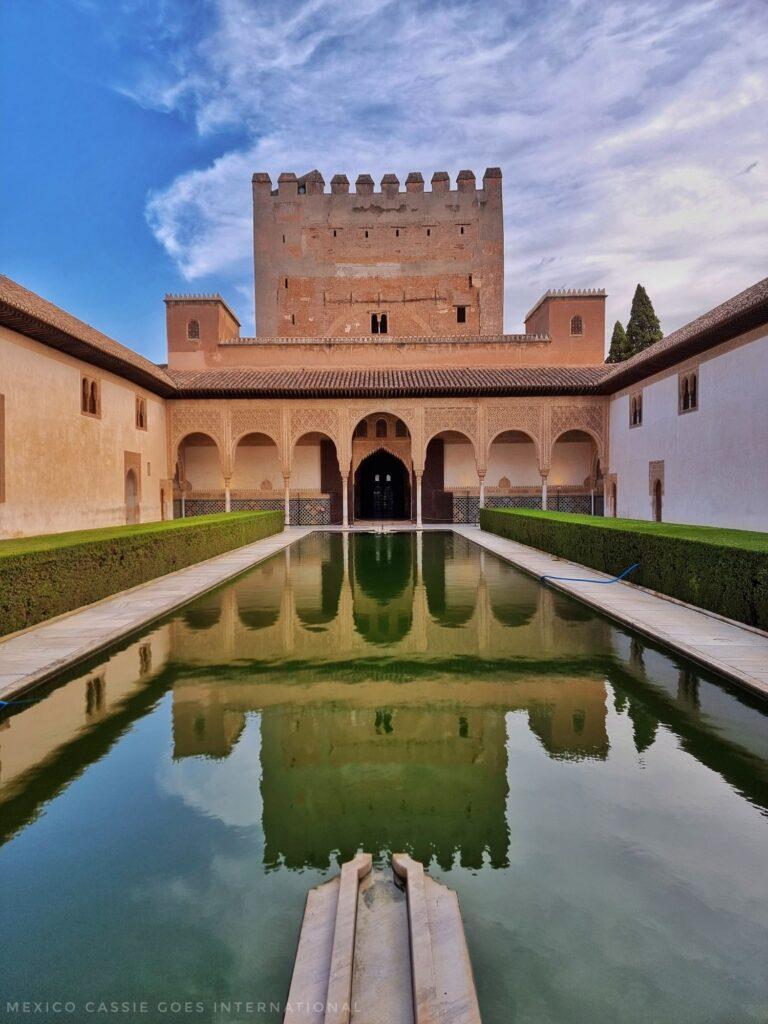
Granada is a fabulous day trip from Seville. The biggest draw is, of course, the magnificent Alhambra. It is absolutely imperative to book your tickets in advance or you will not get to see this gorgeous place. Tickets to the Alhambra include the Alcazaba, the Nasrid Palaces and the Generalife Gardens & Palace. I recommend starting with the Nasrid Palaces, then heading to the Generalife and leaving the Alcazaba for last.
🔎 The Alhambra, along with the Albayzín (also written Albaicín) and the Generalife, constitute a UNESCO World Heritage Site. It is a palace/fortress complex dating from the 13th century when the Emir, Muhammad I Ibn al-Ahmar began building. Subsequent rulers added to the complex, most significantly Yusuf I and Muhammad V. After the emirate was taken by the Catholic Kings in1492, it became a royal court for Isabella and Ferdinand.
🎟 Book your tickets for the Alhambra
→ On the official Alhambra site
→ On the Tiqets website
→ Book a tour of the Alhambra
What else can you do in Granada?
🔭 Check out the Miradors de San Nicolás, and de San Michel for excellent views of the Alhambra
💃🏻 Granada is a great place to watch a flamenco show. Like Seville’s flamenco scene, Granada’s flamenco is passionate, excellent and very accessible.
🔎 Visit one of the many museums in the city. These include the Museo de la Alhambra, Museo Palacio de las Bellas Artes, Museo Cuevas del Sacromonte or the Inquisition Museum. If you visit with the kids then Science Museum is unmissable.
🧭 Explore the historic centre of Granada including the Alcaicería (the old Moorish market area) & the cathedral.
🗻 Look out at the nearby Sierra Nevada mountains
Getting to Granada
🥇 Granada is best visited by car, group tour or train.
🚂 The train station is nearly 1hr walk from the Alhambra
Travel time: approx 2hr40
→ Check train timetable and prices on Trainline
🛄 You can store luggage at the train station for €5 / bag/ day
🚌 The bus station is about a 1hr walk from the Alhambra
Travel time: 3hr
⭐️ MexicoCassie recommended tour to the Alhambra from Sevilla – a 13hr full day tour of the Alhambra, Nasrid Palaces and the ancient Albaycin neighbourhood.
📚 Read more about Granada
➡️ Planning the perfect 2 days in Granada
Cádiz

People don’t visit the city of Cádiz for any one specific monument or building but it’s still one of the most popular day trips from Sevilla.
Cadiz is a gorgeous seaside town to visit and is easily accessible as a day trip from Sevilla. A day trip to Cadiz offers romantic walks through narrow streets and along the Atlantic Ocean sea-front walkways. The town is jam-packed with history, beauty, great food and there’s even a city beach to enjoy. The city is something of a culinary destination for many.
🔎 Cádiz is considered to be the oldest city in Europe. The city was founded by the Phoenicians around 1100 BCE who called it Gadir.
What can you do in Cádiz?
⭐️ Walking is one of the very best things to do in Cádiz. Walk around the narrow streets of the Old City, and walk along the Campo del Sur. This is a boardwalk that follows the curve of the coast offering spectacular views as it meanders through the Parque Genovés and past old forts.
🏛 Teatro Romano – a first-century BCE Roman theatre and small museum.
🔍 Yaciemento Arquelogocio Gadír – a free archaeological museum about the Phoenician settlers in Cádiz.
🏖 Playa de la Caleta – don’t miss this small and popular city beach flanked by forts.
🏰 Walk to Castillo de San Sebastian, an island castle 400 metres offshore. The castle is closed to visitors but the walk there is a lot of fun.
🔭 Climb either the Cathedral’s Bell Tower or the Torre Tavira Camera Obscura for fabulous views over the city.
🍽 Explore the tapas bars and culinary delights on a food tour of the Cádiz.
Getting to Cádiz
🥇 Cádiz is easy to visit by car, public transport or guided tour.
🚂 Approx a 2 hr journey from Sevilla on the train
→ Check your train time and price options on Trainline
🛄 Book hassle free luggage storage with Radical Storage
⭐️ MexicoCassie recommended full day guided tour of Jérez and Cádiz from Sevilla
Ronda
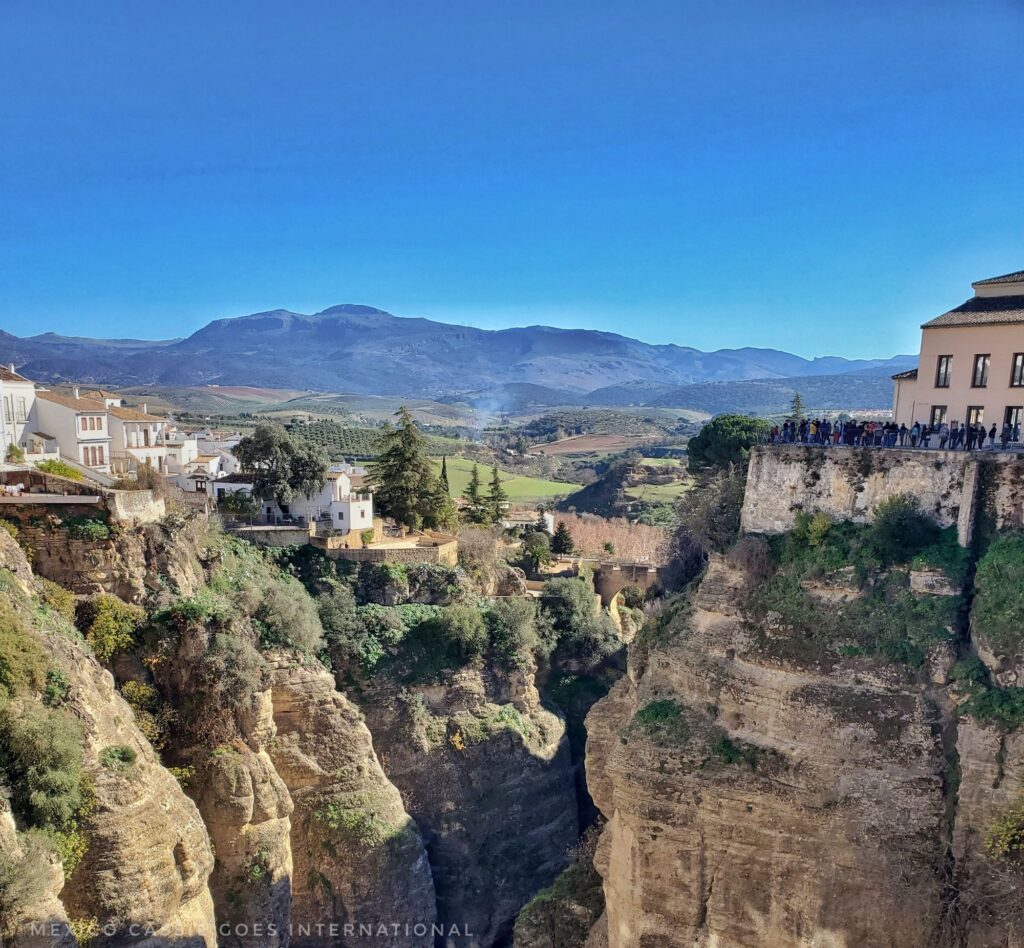
Ronda is an extremely popular destination for people visiting Sevilla. People come to this stunningly beautiful pueblo blanco to check out the plunging El Tajo Gorge that splits the town in two, and to marvel at the 3 bridges that span this deep gorge. However, Ronda is so much more than just this experience. It’s one of Spain’s oldest cities and is just packed full of culture and history.
El Tajo Gorge and its 3 bridges
The bridges over the El Tajo Gorge separate the new town from the old but, in true European style the new town is really not new. In fact it dates from the 15th century more or less and the old town dates from when this region of Spain was under Moorish rule. There is also, of course, an actual modern area of town but most visitors don’t spend much time there.
What can you do in Ronda?
🌉 Check out the 3 bridges, the Puente Nuevo, the Puente Romano/Arabe & the Puente Viejo. Enjoy the views over the countryside.
🔭 Find the miradores for excellent views of the bridges and surrounding countryside: Mirador de Ronda by the bull ring on the Alameda del Tajo; Mirador Puente Nuevo de Ronda – this is a little bit of a trek down perfectly decent paths from Plaza de María Auxiliadora; & Mirador de Aldehuela, which is just over the Puente Nuevo.
🕌 Arab Baths (Baños Arabes) – this is a 13th century bathhouse with a small museum.
📍 La Casa del Rey Moro – here you’ll explore the gardens and then walk all the way down to the bottom of the gorge via the steps in the mine. The steps are perfectly safe to descend and at the bottom is a platform on the river on which you can sit and paddle your feet / take lots of photos
🔍 Visit the city’s small museums including Museo Lara, Palacio de Mondragon (Mondragon Palace), and the Centro de Interpretación del Puente Nuevo
Geting to Ronda
🥇 Ronda is best visited by car, guided tour or public bus.
🚂 20 minute walk to the centre of Ronda. To get to/from Sevilla requires a change in Antequera.
→ Check your train time and price options on Trainline
🛄 Book hassle free luggage storage with Radical Storage
⭐️ MexicoCassie recommended full day tour to Ronda, Grazalema & Zahara de la Sierra
📚 Read more about Ronda
➡️ Everything you need to know about spending 1 day in Ronda
Other excellent day trips from Seville
So, these above are the 4 most popular day trips from Seville but of course, there are other excellent tours to take and places to visit.
In this next section we’ll go, province by province, through some other truly amazing day trips from Sevilla. If you already know where you want to go or which province you want to explore, you can jump straight to that section:
Sevilla: Carmona | Italica & Santiponce | Alcalá de Guadaíra | Osuna
Cádiz: Bolonia & Baelo Caludia | Pueblos Blancos – Zahara de la Sierra, Arcos de la Frontera | Vejer | Setenil de las Bodegas | Olvera | Jerez de la Frontera | Beaches
Córdoba: Castillo de Almodovar del Río | Medinat al Zahra
Málaga: Antequera | Caminito del Rey
Huelva: Aracena | Huelva & La Rabida | Niebla | Almonastar La Real | Doñana National Park & El Rocío | Beaches
Day trips within Sevilla Province
These day trips are all to gorgeous small towns fairly near to Sevilla. They’re great if you enjoy strolling around towns, history and gentle days out.
Carmona

Carmona is a small town with a very long history. The Tartessian and Turdetani peoples settled here, as later did the Phoenicians and the Romans. During Julius Caesar’s reign, the town was known as Carmo. The Moors erected the city walls and various Moorish caliphates held Carmona but in 1247, Fernando III of Castille captured the town, leaving a Christian minority ruling over a Muslim majority.
Enjoy strolling through the narrow streets, gazing at impressive buildings and the fabulous views of the surrounding countryside.
Highlights of Carmona
⭐️ Puerta de Sevilla and the Alcazar de la Puerta de Sevilla, Carmona’s most famous site. There has been a fortress at this location since the 14th century BCE and Julius Caesar apparently called Carmona, “the strongest city in Betica”. Today, you can climb the ramparts for fabulous views of the region.
🏰 Alcazar de Rey don Pedro – located next to the gorgeous Parador (hotel) is a large ruined castle/fortress that offers great views over the city.
🪦 Necropolis and Amphitheatre – the Roman cemetery and amphitheatre are located next to each other a short walk from the old town of Carmona.
➕ The Puerta de Cordoba is a second well-preserved Roman city gate. Plaza de Abastos is a delightful square that is a good option for a coffee or cold drink in the shade as you explore Carmona. The Museo de la Ciudad is a small and interesting museum of the town’s history beginning as a Copper-Age settlement and bringing visitors to the modern day. Plaza de San Fernando is a great place to stop for lunch in one of the many excellent restaurants here.
How to get to Carmona
🥇 Carmona is best visited by car, bus, or on a guided tour. There is also a bus between Carmona and the airport.
✈️ Carmona is fairly close to the Seville airport, which makes it a great final stop if you’re leaving by plane
🚗 40 minutes on the A4 between Sevilla and Carmona
🚌 40 minutes from Sevilla
⭐️ MexicoCassie recommended full day private tour of Carmona – visit all of Carmona’s monuments, wander the gorgeous streets and explore with your own local guide
Itálica & Santiponce

Santiponce, just seven kilometres north of Sevilla, is home to the Roman ruins of Itálica. Itálica was founded in 206 BCE by Publius Cornelius Scipio for soldiers returning from the Second Punic Wars. It was the first Roman city to be built in Spain and apparently also the first Roman city outside of Italy. The amphitheatre is one of the largest ever built, with a capacity of 25,000 spectators.
Highlights of Santiponce and Itálica
🏛 Itálica. The section that’s open to visitors is Nova Urbs and it’s really very impressive. When you enter the site, the amphiteatre is more or less in front of you and the remains of the town are to your left. Be sure not to miss the Casa del Planetario and the Casa de los Pajaros. Apparently, the amphitheatre appeared in a couple of seasons of Game of Thrones so if you’re a fan, be sure to check it out.
🏛 Roman Theatre. Sadly this site is closed to visitors but you can walk around the outside and get a good idea of its impressive size.
⛪️ Monastery of San Isidoro del Campo – this was declared a national monument in 1872. It comprises two Gothic-style churches and two cloisters built in the Mudejar style.
How to get to Itálica
🥇 Itálica is an easy bus ride from Sevilla. There are also great tour options.
🚗 SE-30 ring road towards Mérida until exit 808 and then enter the N-630.
🚌 M170A from Plaza de Armas bus station in Seville.
🚉 Line C5 from Santa Justa Station in Seville and get off at Valencina-Santiponce. You can then take a taxi to your destination.
⭐️ MexicoCassie recommended tour of Itálica – a 4hr tour including guided tour around Itálica and the Monastery.
Alcalá de Guadaíra

Alcalá de Guadaira is a beautiful small town an easy twenty-minute drive from Sevilla. Historically it was of huge strategic importance to Sevilla since both bread and water were supplied by Alcalá to Sevilla. Alcalá de Guadaíra is a perfect place to spend a day exploring given the amount of green spaces and the town’s dedication to, and joy of, sharing its history with visitors.
Highlights of Alcalá de Guadaíra
🌳 Parque Oromana and the many other parks lining the banks of the Guadaíra River. Come with a picnic and spend the day enjoying the river under the shade of the many gorgeous trees. Do not miss seeing the Dragon Bridge or the molino trail along the river (there are 9 mills in all).
🏰 Castillo de Alcalá de Guadaíra and the Church of Santa María del Álguila. These two imposing buildings stand proudly overlooking the town.
🔎 Museo de Alcalá de Guadaíra & the Harinera de Guadaíra. These are the town’s 2 museums.
🥮 Enjoy traditional Alcalá bread and pastries as you stroll through the narrow streets and gorgeous plazas of this old town. Be sure to stop in at the Cueva de la Zarzamora (a fabulous cafe in a wonderful hodge-podge of cave and old houses) or the Pastelaría de la Centenaria for a snack.
How to get to Alcalá de Guadaíra
🥇 Alcalá de Guadaíra is best visited by car (or cab). There are no guided tours to Alcalá so the best thing to do is use my thorough article to explore on your own.
🚗 an easy journey on the A92 between Sevilla and Alcalá de Guadaíra
🚌 M122 or M121 from Calle Cantiana in Sevilla
📚 Read more about Alcalá de Guadaíra
Osuna
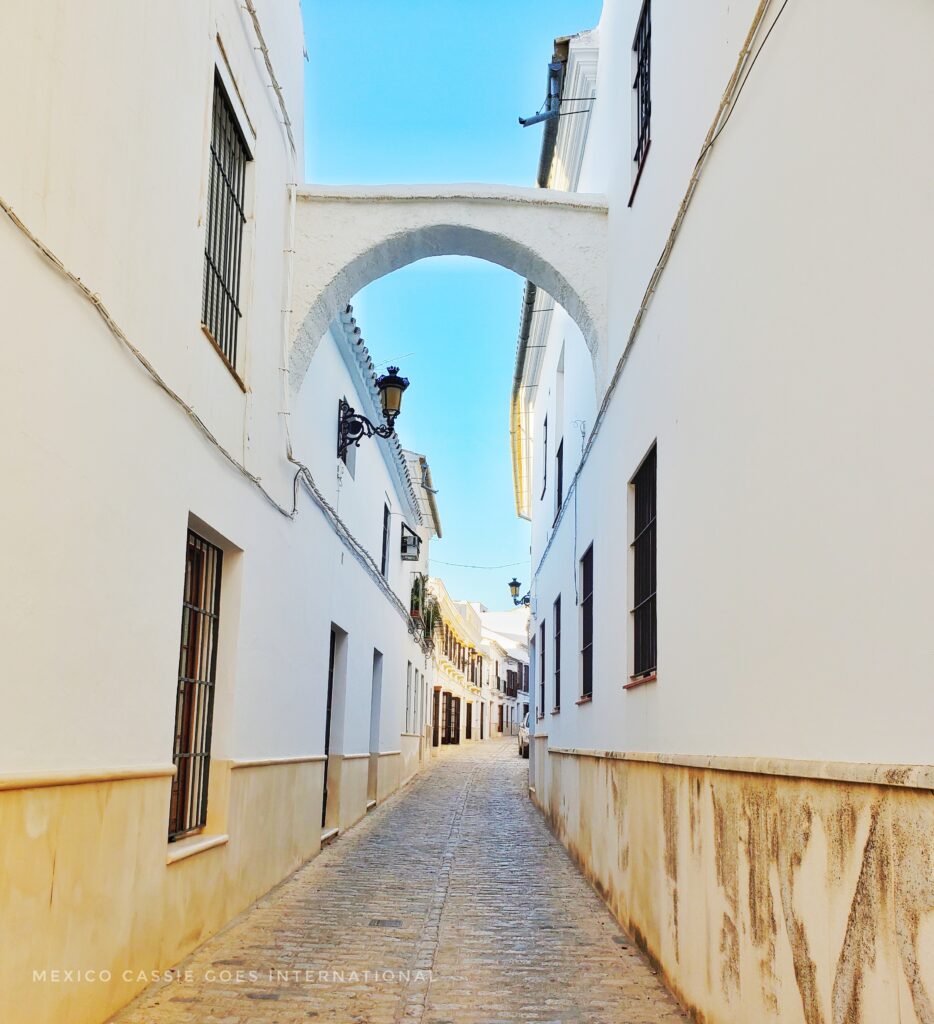
This rural town rarely sees large numbers of visitors but is absolutely worth a day of your time. If you’re a Game of Thrones fan you’ll be excited to know that some scenes were filmed here.
Osuna is not quite as old as some other towns in Andalucia, clocking in at around a mere 3,000 years old. The earliest inhabitants were the Turdetani and when the Romans made it their own it was called Urso. Of course, like everywhere else in southern Spain, Osuna has a long Moorish history too. The Moors called the city Oxuna. Fernando III of Castile and his army captured Osuna in 1239 and in 1264 the town was handed to the Order of Calatrava. The town’s strategic location meant it became a crucial point for the defence of Castile against Granada’s Nasrid Kingdom.
Highlights of Osuna
🧭 Wander the streets – my favourite thing to do in Osuna is stroll around and marvel at all the gorgeous architecture. There are many plazas where you can enjoy a caña (small beer) and watch the world go by and Osuna is full of churches worth sticking your head though the door. Calle de San Pedro was declared one of the most beautiful streets in the whole of Europe by UNESCO. Knowing this, you just have to visit to see for yourself, right?
👀 Don’t miss the Palacio de Govantes y Herdara as you wander around. It is one of, in my opinion, the most amazing buildings in Osuna. I was mesmerised by the wonderful spiral columns.
🔎 Museo de Osuna – including two rooms dedicated to the Game of Thrones filming.
⛪️ Collegiate Church of Our Lady of the Assumption is a pretty spectacular Renaissance church with a crypt where the dukes of Osuna are buried. It sits on a hill above Osuna so the views are great, too.
🏛 Quarry and Coto de las Canteras – In the quarry, which by the way, has been in use for thousands of years, you’ll find monumental sculptures that bring to mind the Egyptian Valley of the Kings although they have nothing to do with Egypt. They are actually rare copies of Turdetani art but at least five times bigger. The originals are in the Archaeological Museum in Madrid.
🏛 Turdetani Roman Necropolis – the necropolis is just there at the edge of the road, completely free to be explored. You’ll find a number of caves built into the soft sandstone walls but there’s little else to see. We spent a joyful half an hour poking around the muddy caves here.
How to get to Osuna
🥇 Osuna is an easy trip by car, bus, or train.
🚘 1 hr on the A92 from Seville.
🚂 From Sevilla Santa Justa 1hr20
→ Check timetables and buy tickets on Trainline
🚌 Approx 1hr30 on the bus
Day trips into Cádiz Province
Cádiz is famous for its pueblos blancos and its gorgeous beaches. Day trips into Cádiz are best taken with your own car or on a tour. However you decide to explore Cádiz, you won’t regret it.
Bolonia Beach & Baelo Claudia
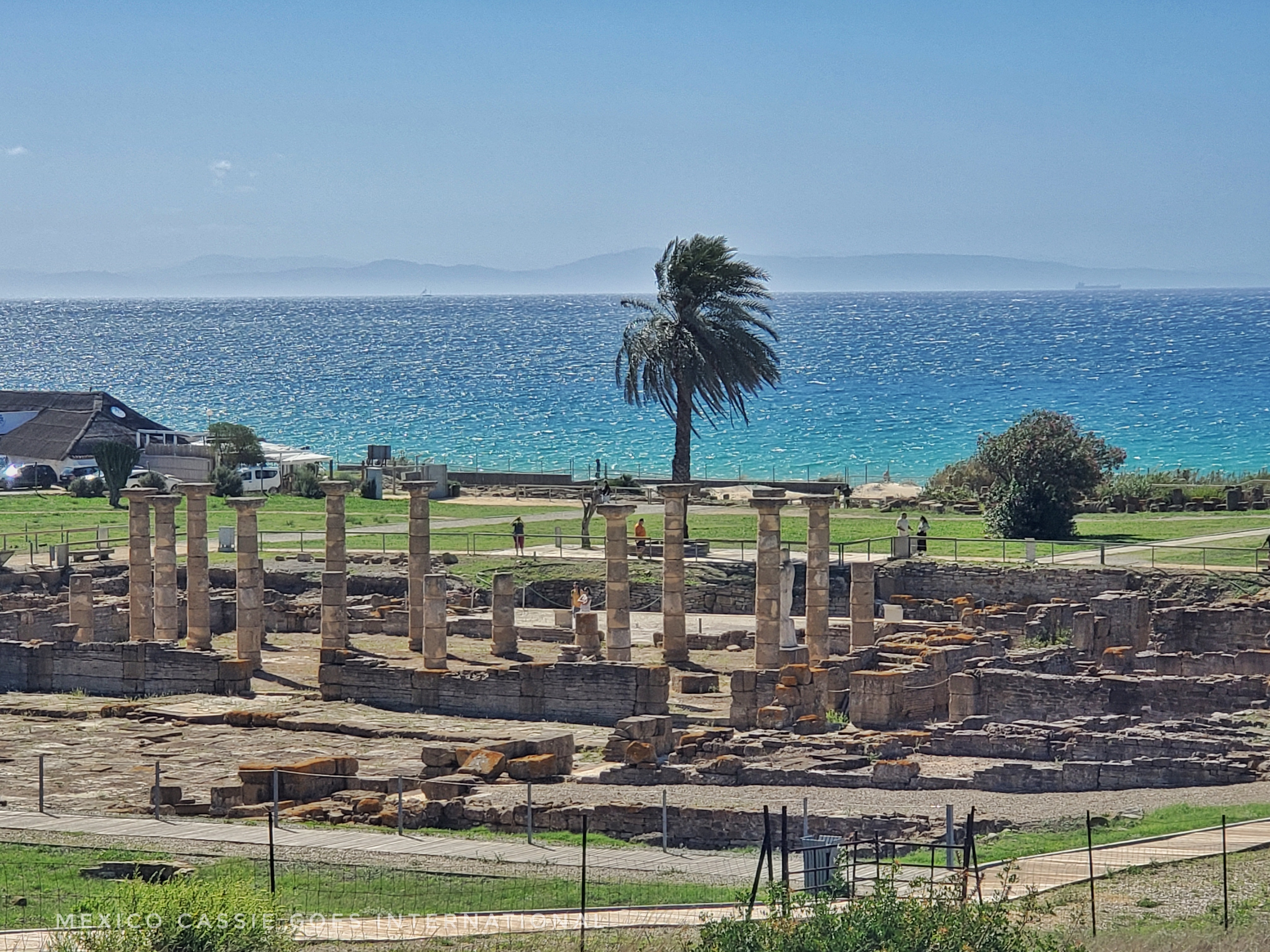
This beach and ruins combo make it into my list of best day trips from Seville because the combination just can’t be beaten.
🏖 In my opinion, this is pretty much a perfect beach. It’s one of the most beautiful beaches I’ve ever seen because of its incredible, enormous dune at one end and incredible views over to the coast of Africa. The beach is 4km long and 700 m wide.
🏝The sand dune is actually a protected natural monument but you can climb it.
🏛Another huge highlight of this beach is the unparalleled views of Roman ruin of Baelo Claudia, which sits along side the beach and is free to enter via the visitor’s centre. There is a small but informative museum to check out before heading down to the ruins of the 2nd century BCE Roman city.
🥙 There are chiringuitos (beachside restaurants) along the beach so either bring a picnic or reserve a table for lunch.
How to get to Bolonia & Baelo Claudia
🥇 Bolonia and Baelo Claudia really require a car or guided tour. There is a bus between Seville and Zahara de los Atunes, which is a small town 5 miles from Bolonia.
🚗 205 km 2 hr15
⭐️ MexicoCassie’s recommended full-day trip to see the ruins, Bolonia and the gorgeous coastal town of Tarifa.
📚 Read more about Bolonia & Baelo Claudia
The Cádiz Pueblos Blancos
🩼 The pueblos blancos of Cádiz are often on steep mountainsides or atop monolithic hills – not the best option for people with mobility concerns. These are just a a few of the publos blancos in Cádiz.
🥇The pueblos blancos of Cádiz are best visited by car or on a guided tour. There are buses to some of these towns from Sevilla but this definitely isn’t the best way to visit as you’ll spend more time on buses than seeing anything.
⭐️ The very best tour of the pueblos blancos of Cádiz that I have found visits Ronda, Setenil de las Bodegas, and Zahara de la Sierra allowing 3 hours in each location.
Zahara de la Sierra
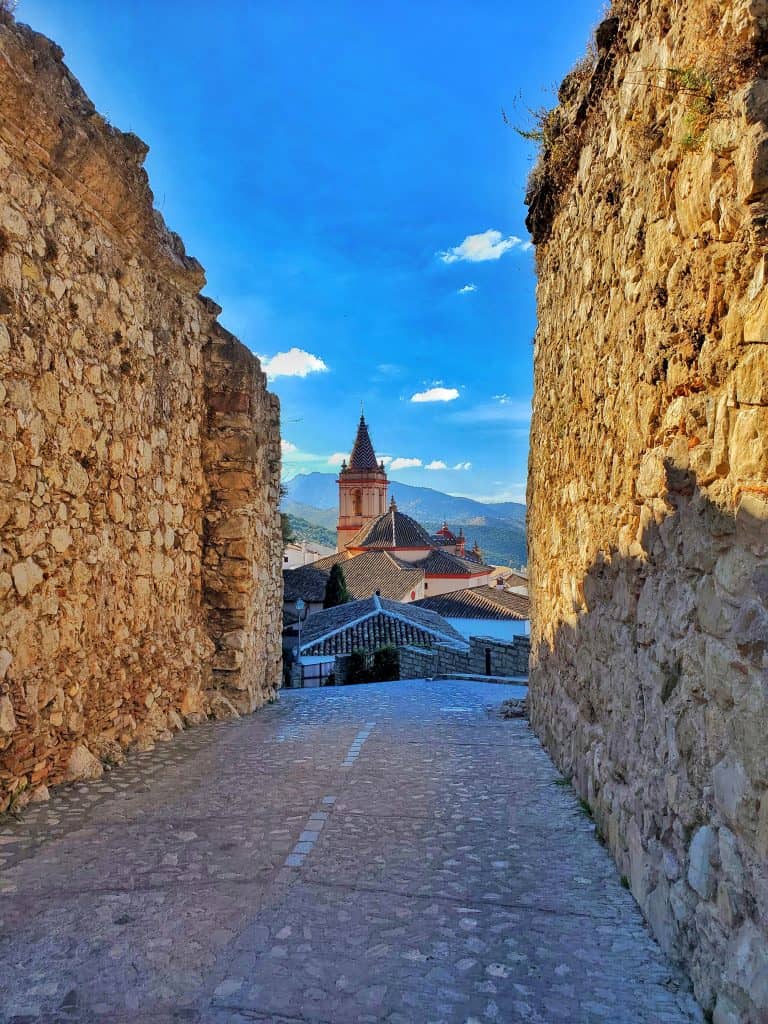
Zahara de la Sierra is a small mountain town ninety minutes to the south of Sevilla. Originally a Moorish outpost, today it is famous for being one of the most beautiful ‘white villages’ (pueblos blancos) in Spain. It sits atop a craggy outcrop, which adds to its splendour.
Zahara de la Sierra was taken by the Christians in 1407 but retaken by the Emirate of Granada in 1481. This event was the catalyst for the Castilian war against Granada. The town was recaptured by Castilian troops after a two-year battle, in 1483.
Highlights of Zahara de la Sierra
⭐️ Walking aimlessly around Zaharah de la Sierra is one of the true highlights of this cute little town. Don’t forget to visit the Santa María de la Mesa Church, the San Juan de Letrán Chapel, the Torre del Reloj and the Palominos Bridge.
🔭 Find all the miradors with their striking views over the Zahara-El Gastor Reservoir.
🏰 Visit the castle and medieval town ruins at the top of the mountain.
🌳 Walk in the surrounding Sierra de Grazalema Natural Park.
Arcos de la Frontera
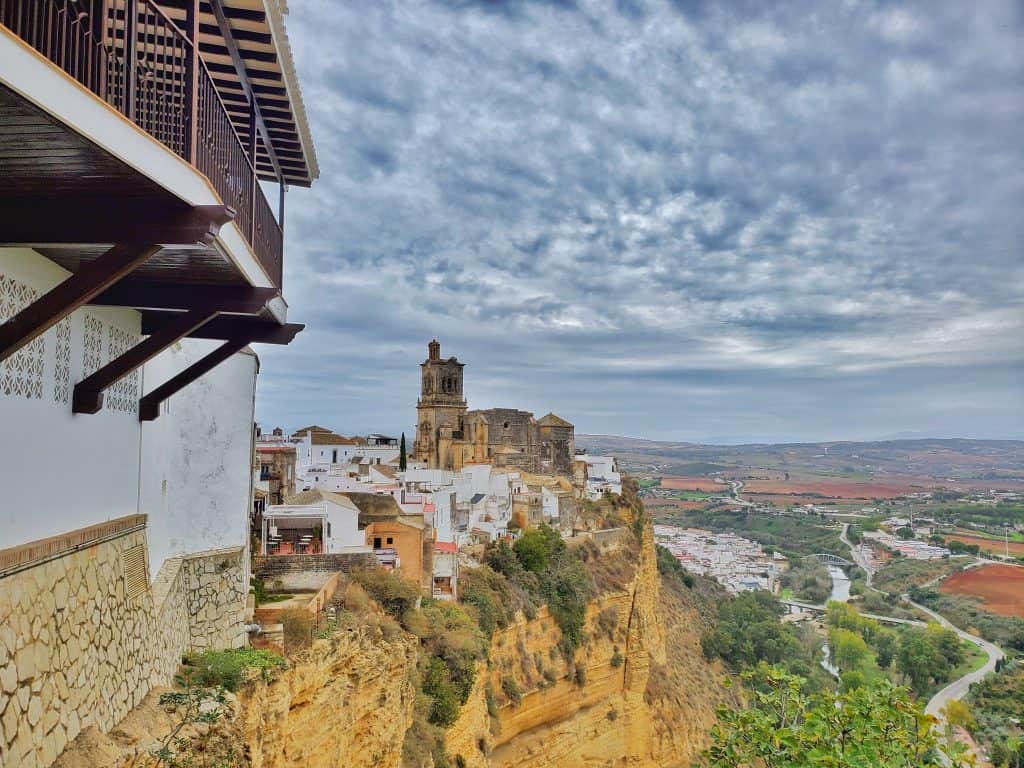
Arcos de la Frontera is another of Spain’s most beautiful towns and it’s just ninety minutes from Sevilla, making it a perfect day trip from Sevilla. Arcos de la Frontera sits atop a peña (monolith), which adds to its charm and is famous for its ten church bells.
The name Arcos de la Frontera refers to the fact that this was a frontier town during Spain’s Moorish period. For a short while during the eleventh century, Arcos de la Frontera was an independent Berber kingdom but in 1255 it was claimed by Alfonso X for Sevilla. It served as a border between Moorish and Christian Spain until the fall of Granada in 1492.
Highlights of Arcos de la Frontera
⭐️ Begin your amble through town on Plaza de Cabildo (the main square) with the mirador (viewpoint) and parador (hotel and restaurant). Enjoy the views from the mirador and then head to the parador’s terrace for a coffee or a beer so you can relax while really taking in the gorgeous views. Note the beautiful churches, the alleyways, and the steps everywhere.
🔭 Mirador de Abades – the second mirador in town also provides gorgeous views.
🌳 Jardín de Andalusí – a peaceful Spanish-Moorish garden.
🏛 Guadacantones – these are the buttresses on the old buildings. Don’t miss Callejón de las Monjas where the buttresses prevent the walls of the church from buckling. If you stand around long enough you may get to watch locals drive merrily through this tiny space or the tourists nervously edge through.
Vejer de la Frontera
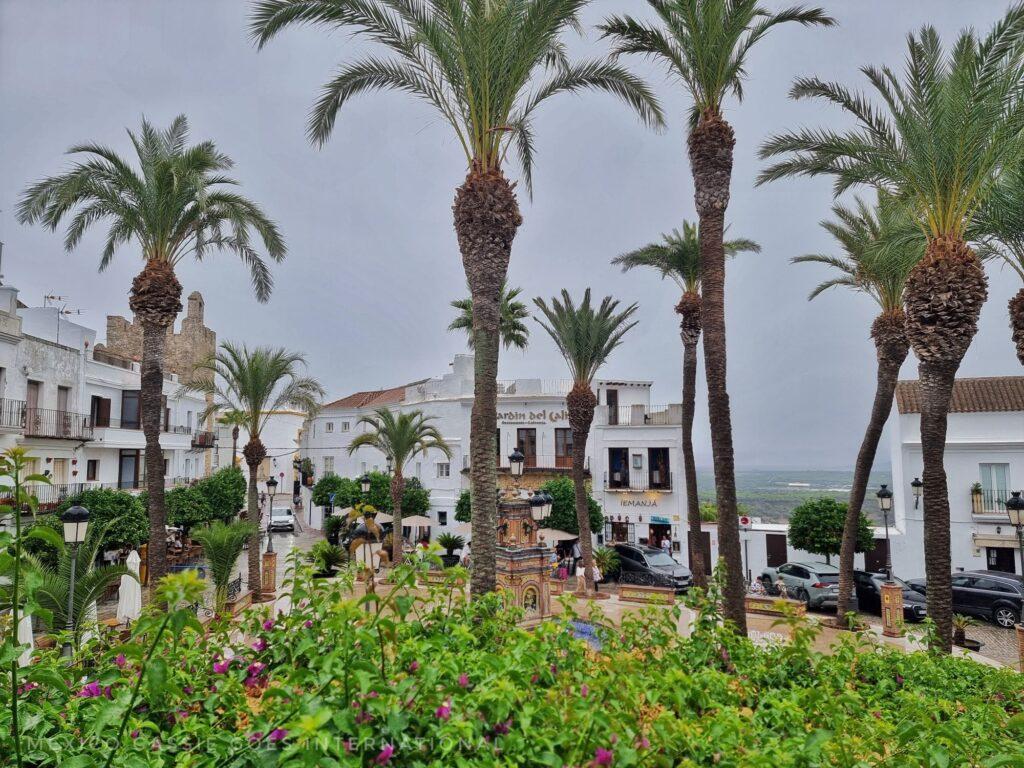
Vejer de la Frontera is a Spanish hilltop town. It was a Moorish town between 711 – 1248 when it was captured by the Catholic Monarchs.
Highlights of Vejer de la Frontera
⭐️ Vejer is a nice little town to walk around. Don’t miss the Plaza de España, the main plaza and its cute shops and restaurants. The views over the town and surrounding area from the Torre de Mayorazgo are a delight. Entrance is via the Casa de Mayorazgo. Try to find the Puerta Cerrada and the Puerta de la Villa.
Setenil de las Bodegas

This small mountain town is famous for being its whitewashed houses built into the cliffs, natural caves and overhangs along the Río Trejo. It is thought that the town’s name comes from the Latin phrase “septem nihil”, seven times nothing, which refers to the Moorish town’s resistance and the seven sieges apparently carried out by the Christians to get it back.
Highlights Setenil de las Bodegas
⭐️ This is one of those tiny towns where you can pretty much see everything just by wandering around without too much of a plan. People do stay in Setenil de las Bodegas though, for the thrill of staying in a cave home. Take a photo at the Bésame en este Rincon sign – (kiss me in this corner). This is a cute bench presumably erected for Instagram. I didn’t kiss anyone here (sob, poor me) but we did go into the tiny cafe just behind and enjoy a drink and a snack on the cliff-house balcony. That felt pretty special.
🪨 Calle Cuevas del Sol and Calle Cuevas de la Sombre – these two streets offer up the most famous and recognisable shots from Setenil de las Bodegas. On either side of the Río Trejo these two streets are lined with restaurants, bars and shops built into the rocky walls. Calle Cuevas de la Sombre (Shadow) runs right through the rock at one point.
🔭 Mirador del Carmen – The Setenil city letters are here and there’s a small playground up here too.
🛖 Calle Herrería – here we found one enterprising old man who was letting people into his house for €1 each. There wasn’t much to see that was any different from any other home apart from its tiny size and rocky walls but his lunch smelled good! Of course, we couldn’t turn up the opportunity to see inside a teeny rock-cave house.
🅿️ there is free parking all along the sides of the road as you drive into Setenil de las Bodegas BUT I don’t recommend relying on this as it goes fast and actually the municipal carpark is better located down at the bottom of the valley.
Olvera
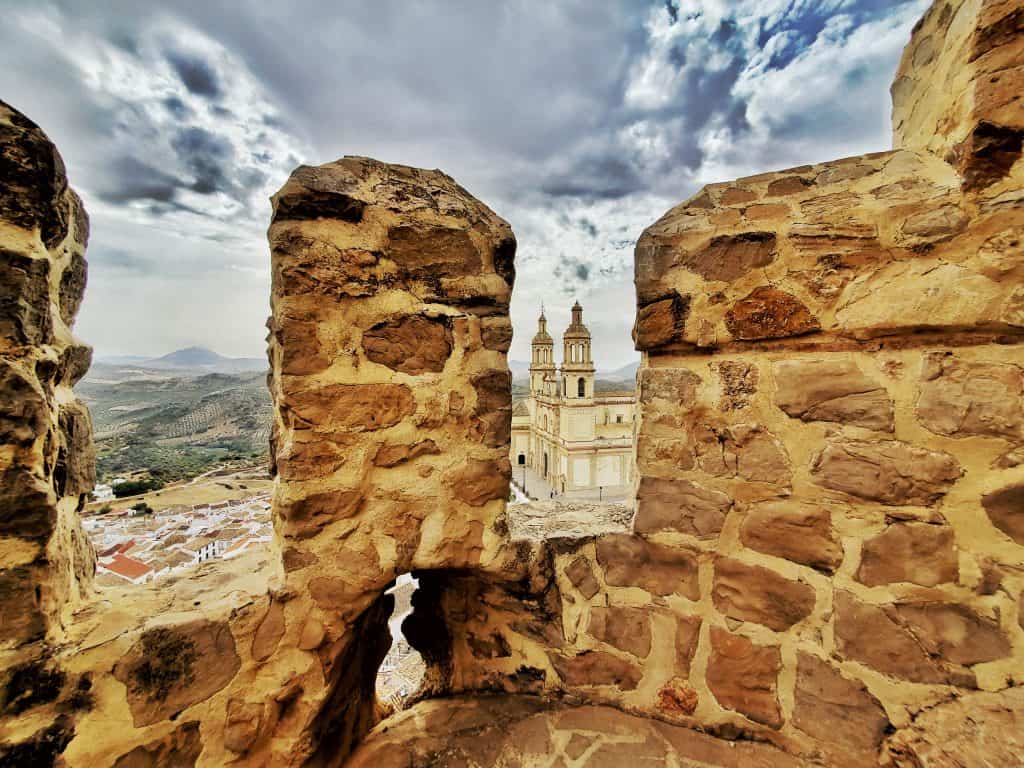
Olvera is a very small town that is home to one of my very favourite castles in Spain and is worth visiting just for this. Olvera was declared a protected area of artistic and historical importance in the late twentieth century.
Highlights of Olvera
🏰 Olvera Castle offers incredible views over the surrounding countryside. Buy your tickets in the tourist information centre. They include entry into a small but informative museum as well as the castle. The castle is reached via the steep steps alongside the church. Once inside the castle compound, there are many more steps to climb.
⛪️ Parroquia de Nuestra Señora de la Encarnación – this is an enormous church that stands next to the 12th-century Muslim castle towering over the small town.
🪨 Peñon del Sagrado Corazon – another climb, this time for views of the castle, church and town.
Jerez de la Frontera
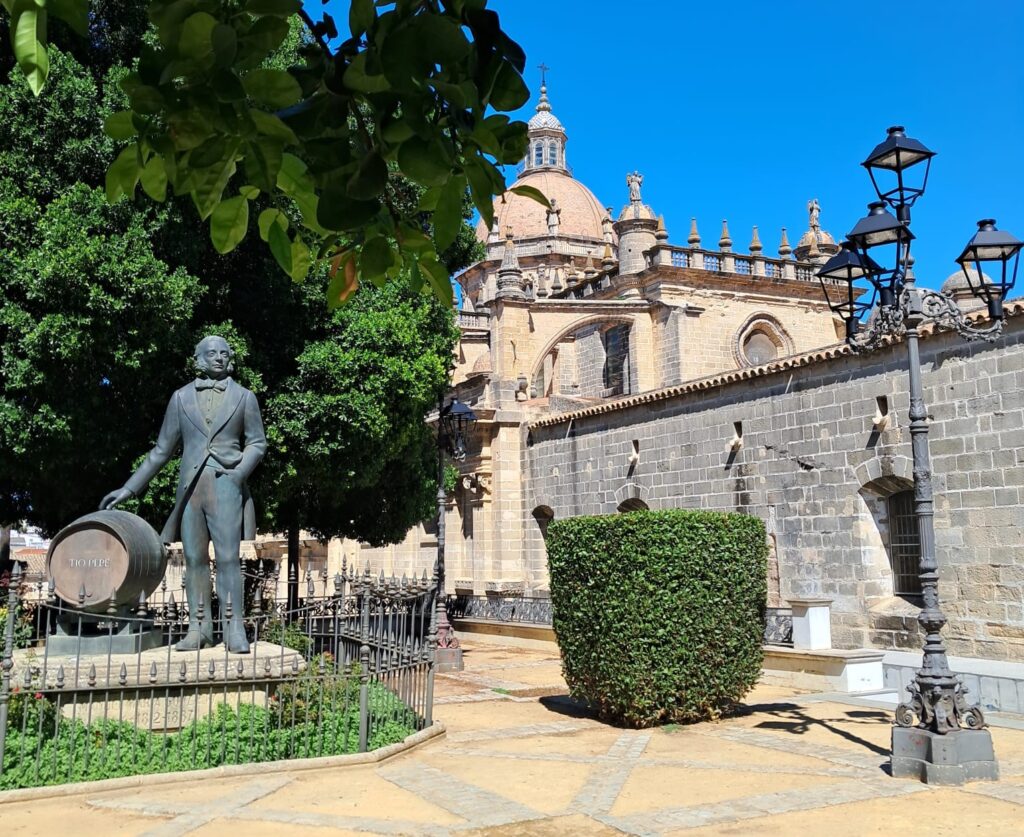
The second major city in the province of Cádiz, Jerez is famous for its sherry (jerez is the Spanish for ‘sherry’), flamenco music and the school of equestrian arts.
Highlights of Jerez
⭐️ Explore the old town of Jerez, enjoy a meal in a tapas bar as you wander around the narrow streets.
🏰 Visit the Alcázar – a Moorish fortress from the 11th century
🥃 Try sherry at a sherry bodega. Sherry can only be made in what is known as the ‘sherry triangle’ – which runs between Jerez de la Frontera, Puerto de Santa Maria and San Lucas de Barrameda.
I’m not a huge fan of sherry but the main bodegas to visit include Tio Pepe, Luis Pérez and Sandeman (and yes, you can also find them in Porto with their port) → Check the tasting options here.
🐎 Visit the Royal Andalusian School of Equestrian Arts, one of the 4 most prestigious riding academies in the world. Here you can watch the riders training every day. Don’t miss the Museum of Equestrian Art while you’re there.
How to get to Jerez
🥇 Jerez is easily visited by car, bus, train or on a tour, take your pick.
⭐️ MexicoCassie recommended tour – spend a full day exploring Jerez and Cádiz. Taste sherries in a Jerez bodega, watch the famous Andalucian horse ballet in Jerez & spend time exploring both Jerez and Cádiz.
Cádiz’s Costa de la Luz
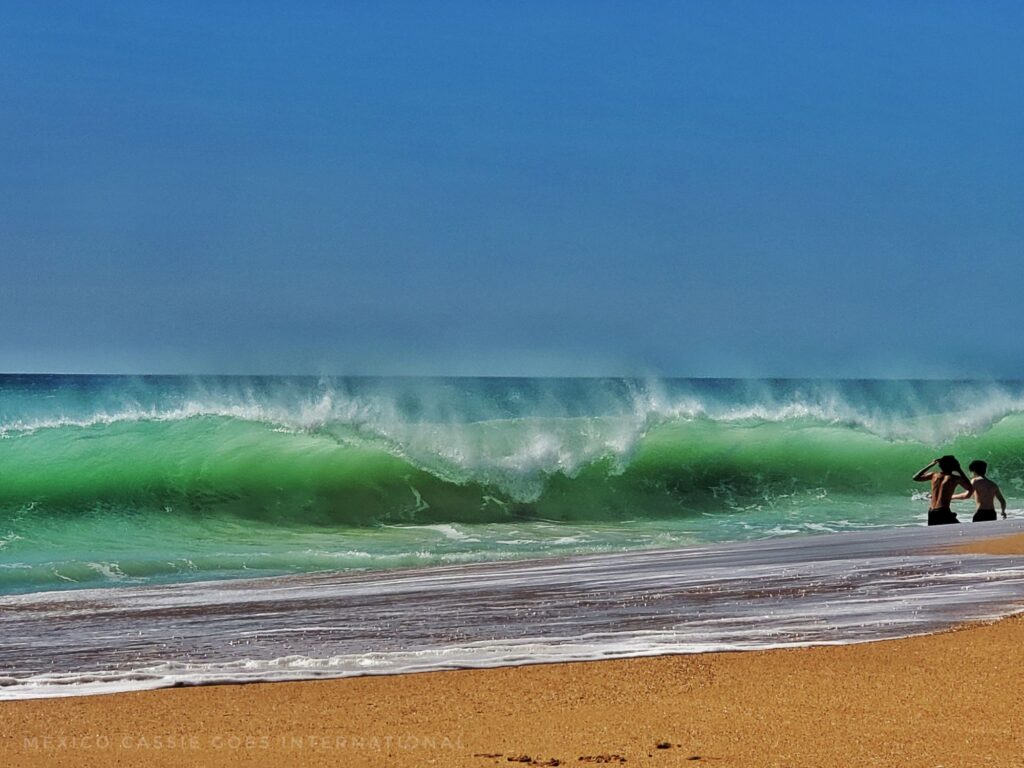
The Costa de la Luz, as Cádiz’s coastline is known, is home to some absolutely marvellous beaches that are within easy day trip distance if you’re staying in Sevilla. I’ve already written about them in a separate article.
🏖 Best beaches to visit from Seville
Day trips into Córdoba Province
For day trips from Sevilla, not too many areas of Córdoba are within reach but these 2 wonderful sites are both feasible if you have your own transport.
Almodovar del Río
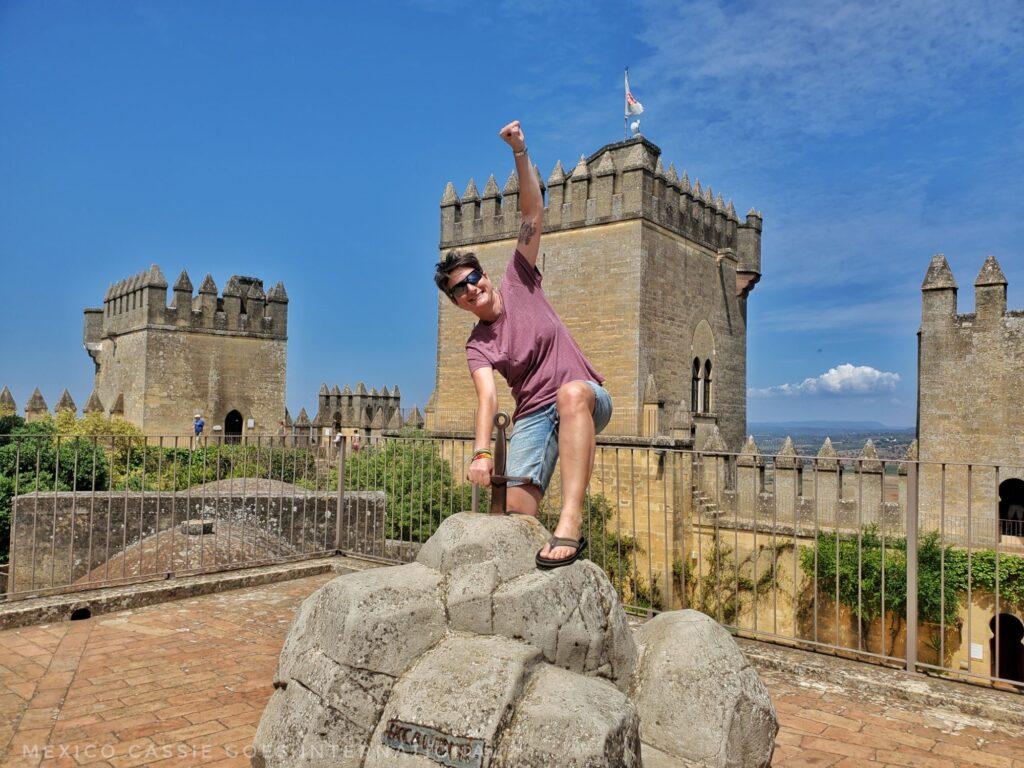
This fabulous castle and fortress sits on a hill overlooking the Guadalquivir. It was built around the year 740 CE by the Moorish rulers of the region. The (fully restored) castle has been open to the public since 2001 and makes for a great day out for anyone who enjoys a good traditional castle. It is particularly a great thing to do if you’re visiting with kids.
🐉 And yes, before you ask, you have seen it in the Game of Thrones
→ Buy tickets to the Castillo de Almodóvar del Río
How to get to Castillo del Almodovar del Rio
🥇 Best visited by car (1hr30). It’s possible by bus but quite a slow option and then requires a climb up the steep hill to the castle.
Medinat al Zahra
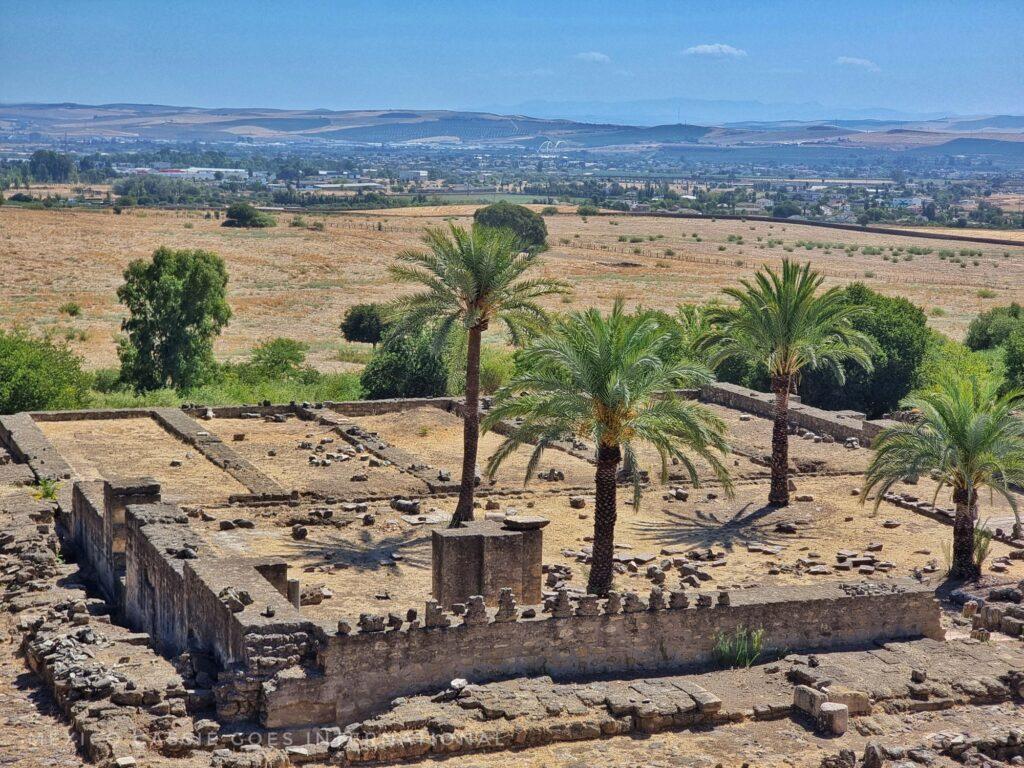
Also written as Medinat Al-Zahra, this is a fascinating archaeological site just outside Cordoba.
This site was built in the 10th century and was once the capital of the Umayyad Caliphate in Spain. Today it is a UNESCO World Heritage site where you can see the remains of the city, part of an early medieval palace as well as the gorgeous ruins of the Mezquita (the first in Spain to point towards Mecca).
👣 We visited without a tour but I actually wish we’d gone with a guide as there is so much to see and learn here and I know we missed out by not having an expert by our sides.
🚌 You park/arrive at the excellent visitors’ centre with a small museum. From here you have to take a bus (€3 per adult €1.50 per child) to the actual ruins.
→ Take a 3 hr tour of the Medina Azahara with a certified archaeologist guide.
How to get to Medinat Al Zahra
🥇 Best to drive (1hr35) as there is no direct public transport from Sevilla.
Day trips into Málaga Province
From Sevilla, there are a few excellent day trip options in Málaga. These are my 2 top recommendations.
Antequera

Antequera has a history that stretches back at least five thousand years. The earliest known inhabitants of this region were the Neolithic and Bronze Age Tartessos and Turdetani people. When the Roman Empire fell, Antequera came under the control of the Vandals and the Visigoths until, in 716 BCE, the Moorish Umayyad Empire conquered Antequera as part of their campaign to dominate the Iberian Peninsula. In 1410, Moorish Antequera fell to Prince Ferdinand from Castille and the city became part of the kingdom of Seville.
Highlights of Antequera
⭐️ The Bronze Age Dolmens of Antequera – Menga, Viera, El Romeral, have been named as a UNESCO World Heritage Site. Menga is considered to be one of the most important pieces of megalithic architecture remaining in Europe. Also considered part of the Dolmens of Antequera are la Peña de los Enamorados
🪨 Just outside the town is the Torcal de Antequera, which is home to some astounding rock formations and is one of my all time favourite places to go hiking in all the world (note, even if you’re not a hiker there are plenty of options for an easy stroll to admire the view and there’s a visitors’ center with a cafe, too).
🏰 Up on a hill in the town is the Alcazaba, It was built between the eleventh and fourteenth centuries. In the eleventh century, Antequera was a minor caliphate but by the fourteenth century, proper fortifications were required to fight off the advancing Catholic Spanish invaders and to protect the Muslim population of Antequera.
🔎 Visit the Museo de la Ciudad de Antequera (Antequera Museum). We particularly enjoyed the ground-floor exhibits that explained the city’s ancient and Roman history. As you climb the museum floors, it turns into an art gallery for local artists, which is also interesting to see.
⛪️ One of the joys of Antequera is walking around the ancient city, admiring the buildings and plazas. There are apparently more than thirty churches in Antequera, this is more per head than anywhere else in Spain.
How to get to Antequera
🥇 The best way to visit Antequera is by car as this gives complete freedom to explore the dolmens, the town and the Torcal. Without a car this would not be possible.
🚗 1hr40 on the A92
🚂 1hr30 – 2 hr by train
→ Check timetables and buy tickets on Trainline
🚌 2hr40 – 3 hr by bus
📚 Read more about Antequera
Caminito del Rey

Another popular day trip from Sevilla is to go hike the Caminito del Rey, by the small village of El Chorro. The Caminito del Rey used to be considered one of the most dangerous hikes in the world but thanks to some much needed restoration work, it is no longer dangerous at all.
🎟 It is imperative to know that you can’t buy tickets at the Visitors’ Centre, you need to buy tickets in advance online if you wish to walk the Caminito del Rey.
How to buy your tickets: If you are taking yourself to the Caminito del Rey, the ideal is to buy your tickets on the official website. Here self-guided tickets are €10 and guided tours are €18 (both plus booking fee). They sell out fast so if you can’t find them for the date you want, check tour aggregate companies such as GetYourGuide as they will generally have some availability at only a very small premium.
If you do it alone, you have to get yourself to the North Access point as this is where the hike begins. Note that it is a short hike just to get here though.
While none of the walk itself is strenuous if you’re fit, no walking poles are permitted, no children under 8 and you do need to prepare yourself for a 2-3 hour beautiful walk with some up hill and step climbing towards the end..
Much of the walk is on wooden paths attached to the side of the cliff. For me it never felt scary or dangerous but if you’re afraid of heights I can see it might be a little uncomfortable.
MexicoCassie tip: Park at Restaurant El Kiosko and walk through the Tunel de Aceso and along a clear path to the North Access point. Takes a good 40 minutes to walk. Or go to the Visitors’ Centre and take the shuttle bus (and then walk).
Getting to the Caminito del Rey
🥇 To comfortably manage a Caminito del Rey day you need to either drive (2hr ) yourself or take a tour.
⭐️ MexicoCassie Caminito del Rey recommended tour – 10 guided tour from Sevilla- Includes, guide, ticket, transport and a short stop in Osuna.
Day trips in Huelva Province
Huelva receives fewer day tripping visitors from Sevilla than other provinces but in my opinion, it offers far and away the best day trip options especially if you like peace and quiet and incredible views.
Aracena
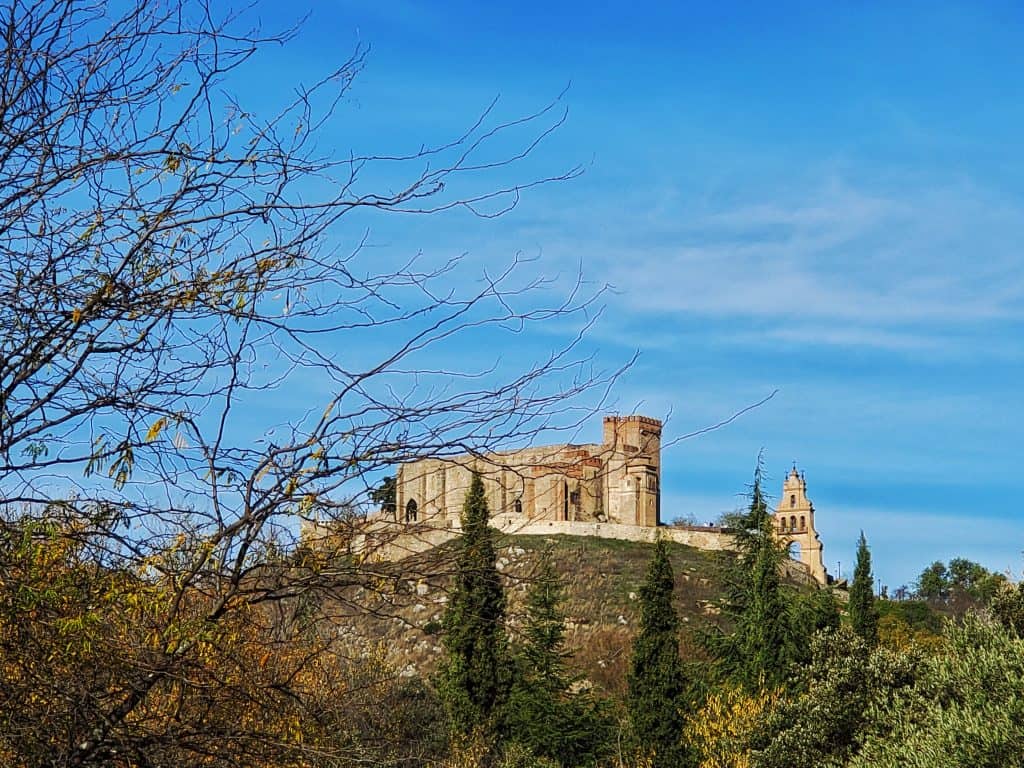
Despite being named a Tourist Municipality of Andalucia, this historic city barely registers on the radar of overseas tourists. People visit Aracena for its natural beauty and for good food.
Highlights of Aracena
🏰 Castillo-Iglesia de Nuestra Señora de los Dolores (Castle and Priory Church) dominates your every moment in Aracena, and you’re unlikely to miss out on visiting this gorgeous combo.
⭐️ The Gruta de Maravillas can only be visited as part of a guided tour that lasts around an hour. The cave system contains underground lakes, stalactites, stalagmites and columns that will utterly wow you.
🌳 Walk around town / Explore Plaza de San Pedro and Plaza de la Gruta de Maravillas – this is the busiest area of Aracena. You’ll find plenty of cafes, bars, and shops as well as the Outdoor Museums of Contemporary Andalucian Art and the Lavadero Fuente de Concejo.
🐖 🍄 Museo del Jamón – a very small museum dedicated to ham and mushrooms.
How to get to Aracena
🥇 Aracena is best visited by car or with a tour as the buses don’t run frequently enough to make it a day trip possibility with public transport.
🚘 1hr20 (90km) on the A66 and A433
⭐️ MexicoCassie recommended tour to Aracena – spend a day exploring around Aracena, visit the Rio Tinto Mines, the Gruta de Maravillas, the Aracena Castle and Aracena town.
📚 Read more about Aracena
➡️ Everything you need to know for a perfect trip to Aracena
Huelva City & La Rabida

Huelva City is the capital city of the province of Huelva and it makes a lovely day trip from Sevilla. Huelva has a totally different vibe to the other big cities of Andalucía, partly due to the enormous earthquake of 1755 that destroyed many of the city’s buildings. Very few international tourists make it to Huelva, which means anyone visiting here gets to experience a true Spanish city with very little impact from tourism.
La Rábida is a small area at the port just outside Huelva city. It is from here that Columbus set sail when he stumbled upon the Americas and changed the course of world history.
Highlights of Huelva and La Rábida
🔎 The Huelva Archaeological Museum is an incredible place with some super interesting displays.
⭐️ The Muelle del Tinto is a very cool structure to see and walk along. It is a 19th century mineral loading platform in the River Odiel docks.
⚓️ Muelle de las Carabelas Museum. Here you can explore replicas of the three ships that Columbus sailed across the ocean, La Niña, La Pinta and La Santa Maria. This is a fascinating place to visit if you are interested in the history of Spanish colonialism and in learning about how the Spanish see view their own history.
🌹 Parque Botanico – the landscaped botanical garden is right next to the Muelle de las Carabels museum and is a lovely place for a stroll. It has small canals, tropical plants and an observation deck.
🛡 Paseo de los Escudos – this pedestrianised road is lined with tiled shields for each Latin American country. At the head of it is a monument to Columbus. Whatever our views of Columbus and colonialism, this is a very peaceful place to walk.
How to get to Huelva
🥇 Huelva is easily visited with public transport or by car. However, if you wish to also visit La Rabida you’ll need to have access to a car or pick up a tour in Huelva.
📚 Read more about Huelva
Niebla
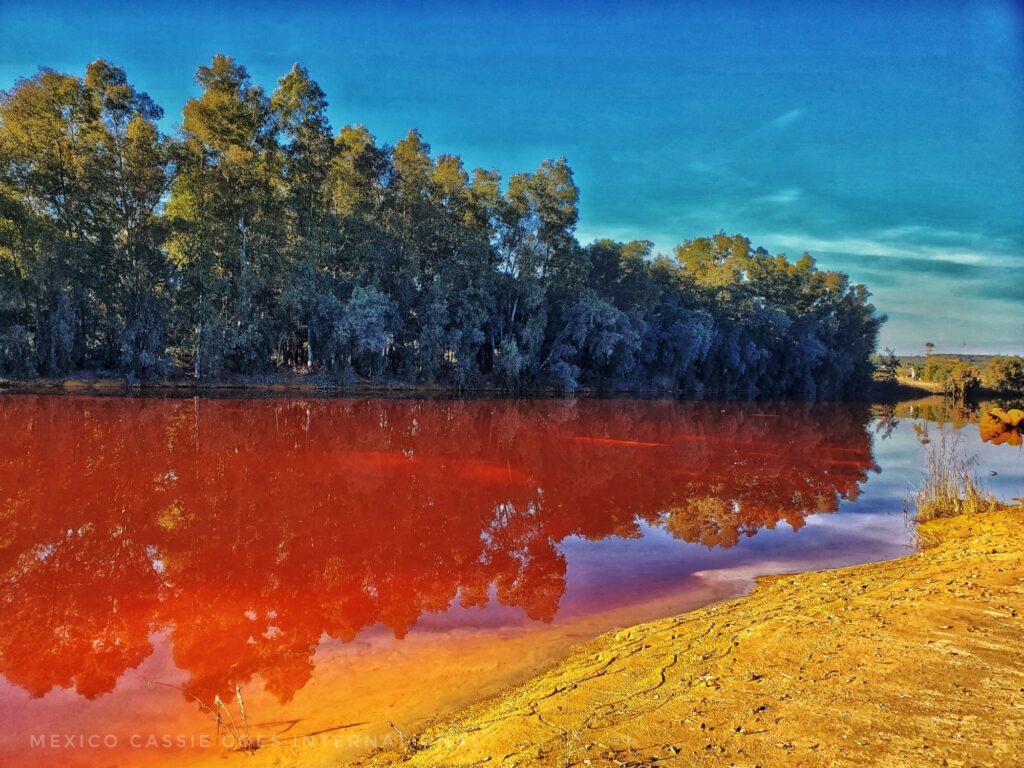
The small town of Niebla is another ‘off the beaten track’ day trip for people who would like to see a small, historic town without other tourists. Niebla is home to one of the most important artistic heritage sites in all of Spain – an Almohad wall enclosing the town.
Highlights of Niebla
🏰 The Castillo de Niebla / Alcázar de los Guzmanes is an interesting place to visit. It was first constructed by the Moorish leaders of the region and was then adapted by the Guzmanes who governed the area under Rey Alfonso.
🪨 Walking over the Roman Bridge and then along the Río Tinto – a properly and interestingly red river (it’s run off from mines that have been in use for thousands of years – don’t touch!)
⛪️ The Iglesia de San Martín – Check out the open air nave. Apparently when the nave’s roof was in danger of collapsing they just removed it, leaving this gorgeous space that will leave you quietly pondering the whys, and wherefores of life.
Getting to Niebla
Niebla is best visited by car as the only bus options give you just 3 hours in town
🚗 50 minute drive
📚 Read more about Niebla
El Rocío & Doñana National Park
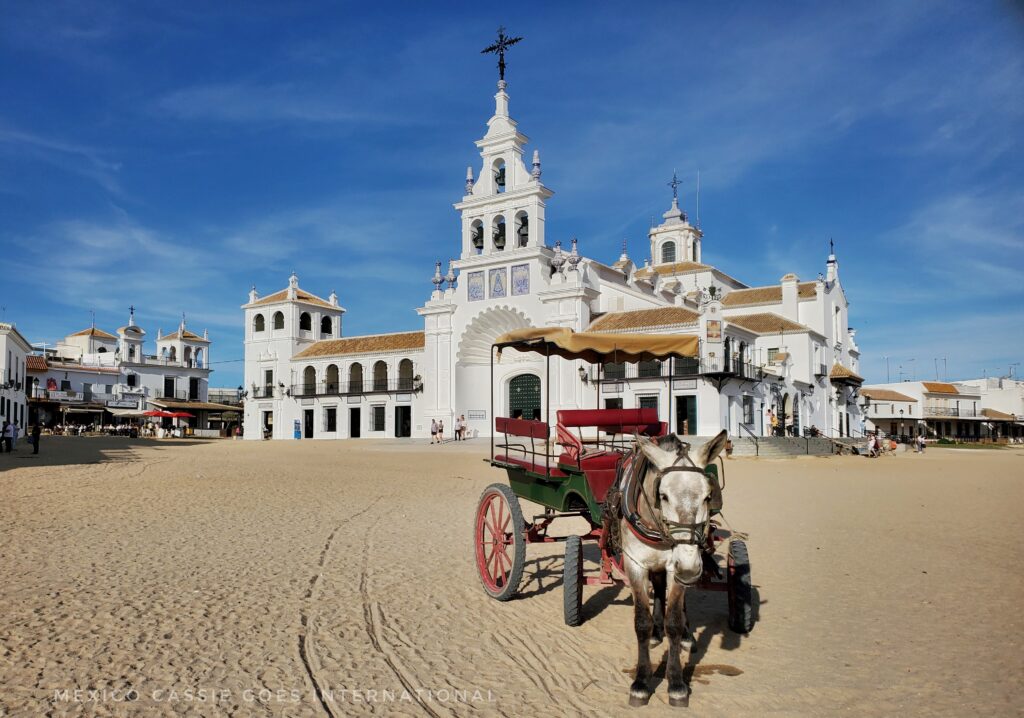
El Rocío is like nowhere you’ve ever seen before. Located on the edge of the Doñana National Park, El Rocío is the location of one of Spain’s biggest and most famous annual religious pilgrimages: Romería del Rocío.
While once a year, in June, approximately 1 million pilgrims come to dance and make merry (yes, really), the rest of the year it is perfectly possible for non-pilgrim visitors to enjoy El Rocío as one of many tourist attractions in the area.
Highlights of El Rocío
🐴 Wander around and take in the sandy streets and gorgeous buildings with horse railings outside. Walk the path along the Doñana wetlands, exclaiming over the horses, deer, flamingos and other wildlife congregating there. You never know, you might even see the elusive Iberian lynx, an endangered species that lives here.
⛪️ Check out the Ermita de Rocío, the imposing white church at the heart of El Rocío. This incarnation of the church was built in 1964 and is the permanent home of Nuestra Señora del Rocío (the wooden image for which this place exists), which can be seen above the main altar.
How to get to El Rocío
🥇 El Rocío is best visited with a car or on a tour.
🚗 1 hr 15 minutes on the A49 and A483 via Almonte
🚌 take a bus from Plaza de Armas. 90 minutes (two buses per day)
⭐️ MexicoCassie recommended tour to El Rocío – spend a 4hr exploring the Doñana National Park in a 4WD, wander around El Rocío and finish up relaxing on the gorgeous Matalascañas Beach.
📚 Read more about El Rocío & Doñana National Park
Almonaster La Real
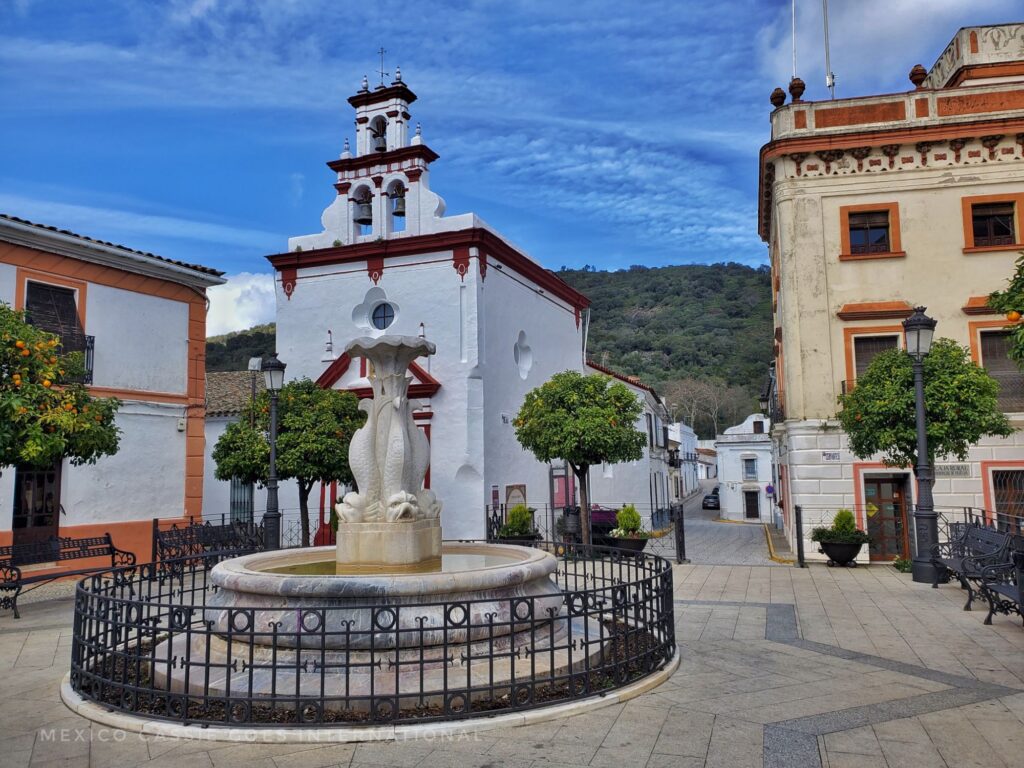
This gorgeous and tiny town in the north of Huelva Province sits on the edge of the Sierra de Aracena and the Picos de Aroche Natural Park. Very few foreigners visit but those who do, go for the architecture, cobbled streets and long history.
Highlights of Almonaster La Real
🕌 Up on the hill overlooking the pueblo is the the tenth century mosque (mezquita). This is one of the few surviving rural mosques in Spain and it’s really an extremely special place to see. Not only is it at tenth century building but its architects also incorporated Visigoth and Roman structural sections into the design.
🔎 Walk around the town, see the plazas, the concejo (communal wash house), enjoy the cobbled streets and the total lack of people! There are a few restaurants in town and all get excellent reviews. We chose one at random (el Mesón Miguel Tenorio) and it was fabulous.
🍄 Expocisión El Buscador de Setas – As you walk up the hill to the mezquita you’ll pass a row of lovingly restored stables, a few of which now house a small local museum dedicated to the human history of the area. It’s well worth spending 20 minutes here especially if the owner is around as he’s a fascinating guy.
How to get to Almonaster La Real
🥇 Without a car you’ll struggle to get to Almonaster for the day from Sevilla as public transport doesn’t reach here from Sevilla.
🚗 1hr40 on the N4333 through some beautiful villages
📚 Read more about Almonaster La Real
Minas de Río Tinto
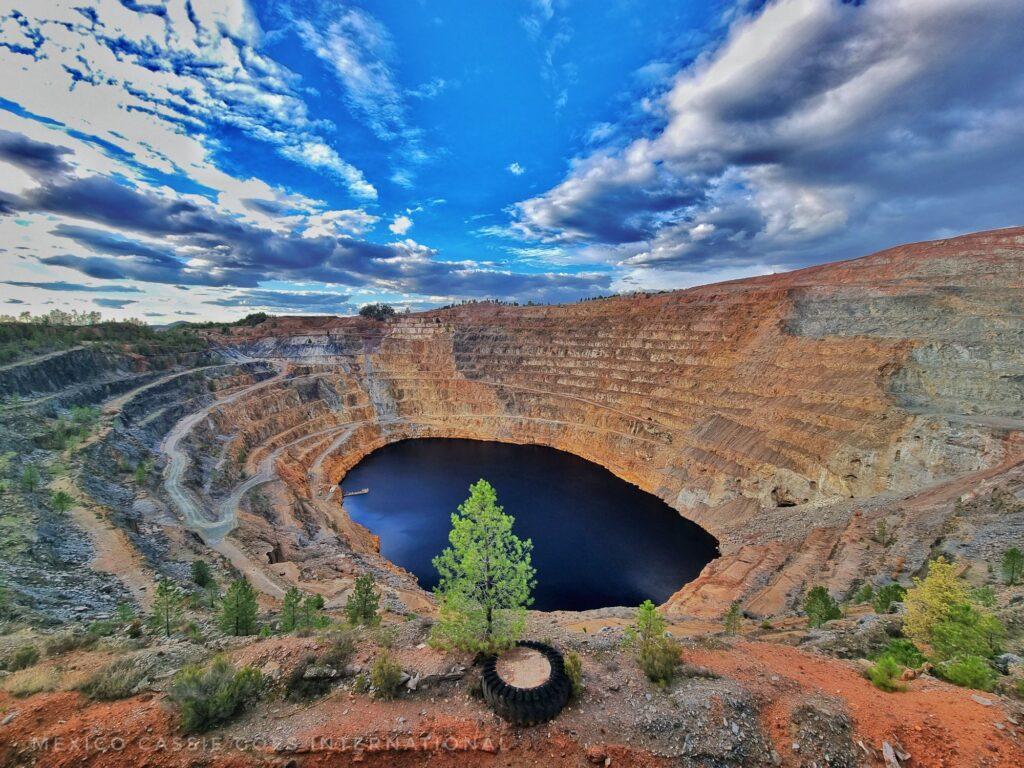
Barely registering for most non-Spanish visitors to Sevilla, are the incredible Minas de Río Tinto in the middle of Huelva Province.
The Río Tinto mines in the middle of Huelva Province are the oldest mines in the world and are well worth a visit, weird as this sounds.
Humans have been transforming the landscape here for 5,000 years. We can see the results of such long & intensive work in the land today. From the gorgeous (and scarily) red river & the carved cliffs to the reforested lands, everything you see is natural yet impacted by humankind.
Highlights of Río Tinto
Today it’s possible to explore this magnificent area either under your own steam or on a tour. The Rio Tinto mines visit includes a 90 minute train journey along the river and mine area (photo above), the mining museum, visit to the Corta Atalya mine site, the Peña de Hierro mine & Casa 21 museum. This is a full day experience.
How to get to the Río Tinto mines
🚗 Check car rental options now (really not possible on public transport) 1hr30 from Sevilla
👣 Take a full day tour from Sevilla to Aracena & the Rio Tinto mines
🍽 Restaurante La Fábrica is an incredible place to eat when you’re in the small town of Minas de Ríotinto.
Huelva’s Costa de la Luz
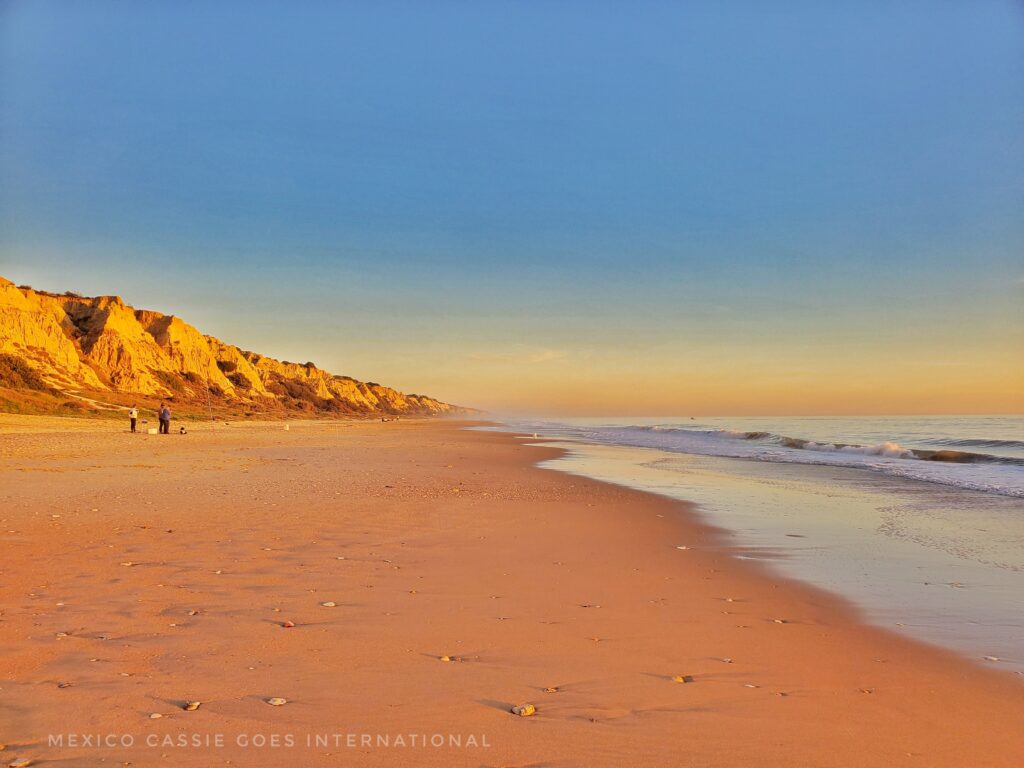
The Huelva coast, like the Cádiz coast is part of the Andalucian Costa de la Luz that runs from Tarifa in Cádiz Province all the way to the mouth of the Guadiana River and the border with Portugal.
Huelva’s beaches typically consist of wide, white sand beaches flanked by dunes and pine forests on one side and the Atlantic on the other. While the Spanish have long treasured these magnificent beaches, foreigners are only recently realising the magnificent beauty of this part of the Spanish coastline.
📚 Read more
🧗🏼♂️ In San Lucar de Guadiana, on the border with Portugal you can zipline across the river that forms the border between the 2 countries. That’s right you can zipline across the border!!!
Note on Portugal & Gibraltar
Gibraltar
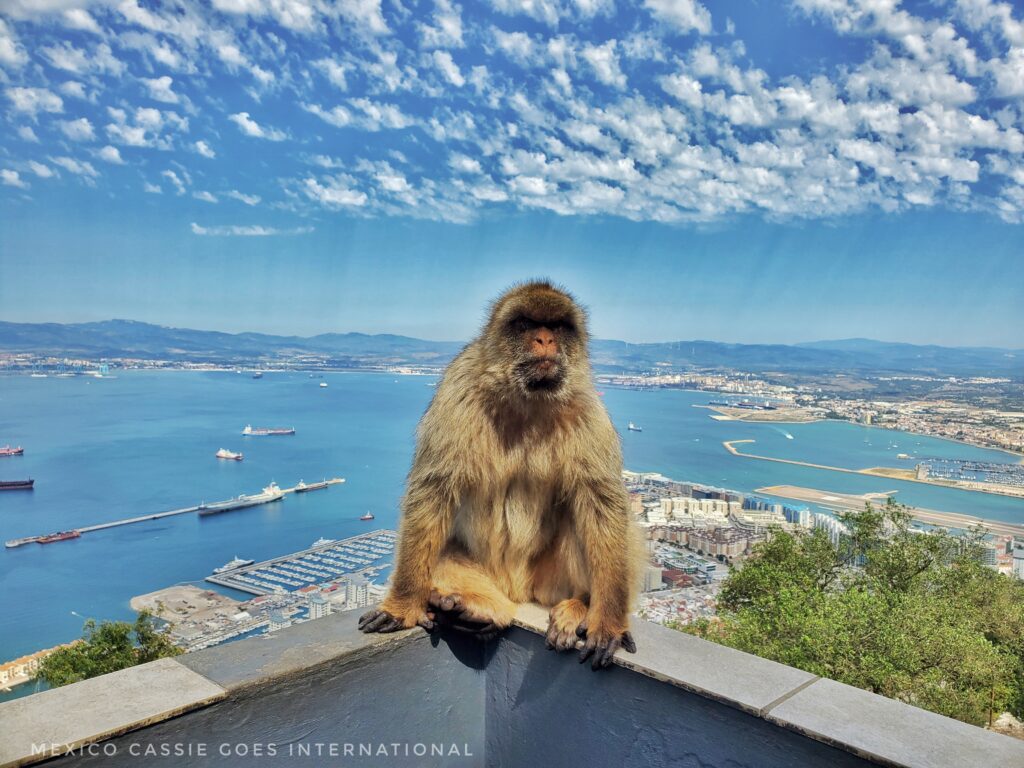
I regularly see people asking about the possibility of taking a day trip to Gibraltar from Sevilla. It is definitely possible and it’s something I do about twice a year. I spend the day exploring, hit the supermarket at about 6pm and am home in Sevilla by 9 or 10pm. I definitely don’t recommend it via public transport.
➡️ Read more about taking a day trip to Gibraltar
⭐️ Check out guided tours to Gibaltar from Sevilla
Portugal
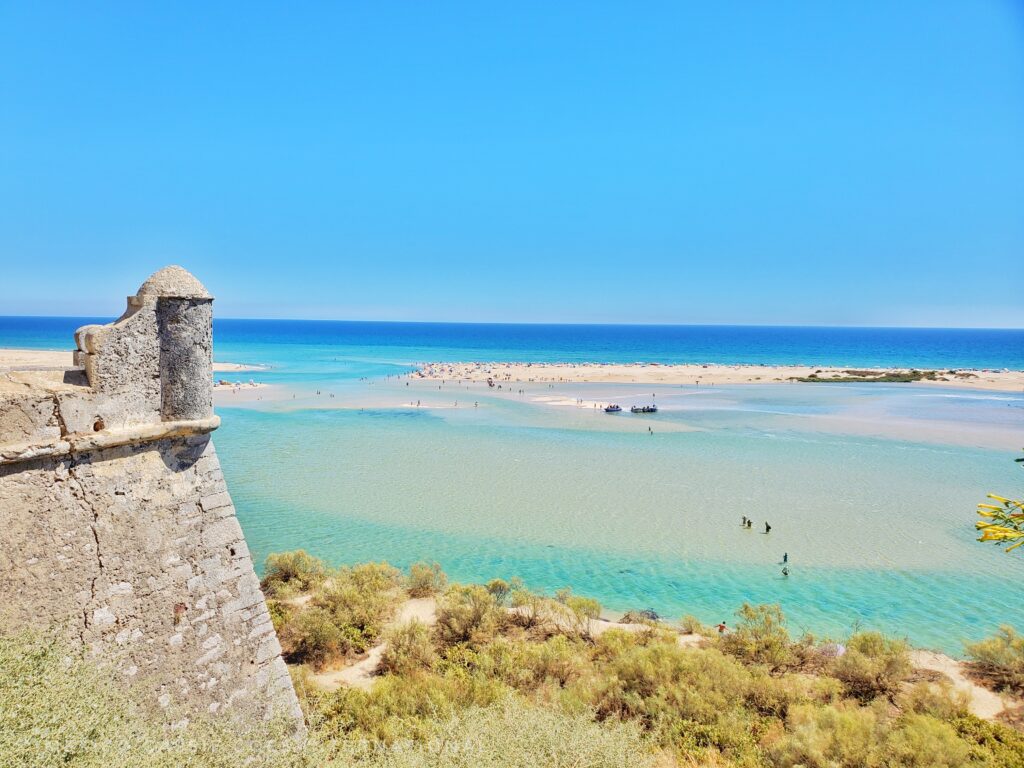
The gorgeous small city of Tavira is just 1hr50 by car from Sevilla. Tavira is a great place to spend a day soaking up Portuguese culture, sun and excellent food.
Faro is just over 2 hours from Sevilla (making it another excellent airport option). I love wandering the streets of Faro’s old town.
There are direct buses to and from Sevilla – Tavira / Faro every day from Sevilla’s Plaza de Armas station.
➡️ Read more about exploring Faro
MexicoCassie’s Andalucía archives
Sevilla
⭐️ What is Sevilla famous for? | ⭐️ How many days do you need in Seville? | ⭐️ Everything about the Seville airport bus
⭐️ 1 day in Seville | ⭐️ 3 days in Seville | ⭐️ 5 days in Seville | ⭐️ How to visit Seville in the summer | ⭐️ How to visit the Alcazar
⭐️ Best beaches from Seville | ⭐️ Day trips from Seville | ⭐️ Seville with kids | ⭐️ Seville with teenagers | ⭐️ How to see flamenco in Seville
Malaga
⭐️ 3 days in Malaga | ⭐️ 1 day in Malaga | ⭐️ Day trips from Malaga | ⭐️ 1 day in Ronda | ⭐️ 1 day in Ronda with kids | ⭐️ What to do in Antequera
Córdoba
⭐️ What to do in Córdoba | ⭐️ Planning your Córdoba day trip from Seville | ⭐️ Exploring Córdoba with kids | ⭐️ 1 day in Córdoba | ⭐️ Zuheros, the most beautiful village in Córdoba
Cádiz
⭐️ What to do in Cádiz province | ⭐️ How to spend 1 day in Cádiz city | ⭐️ What to do in Cádiz with kids | ⭐️ Exploring Tarifa | ⭐️ How to get to Tangier from Tarifa | ⭐️ Exploring Gibraltar
Huelva
⭐️ Is Huelva worth visiting? (YES) | ⭐️ What to see in the gorgeous Aracena
Granada
⭐️ Planning your Granada city break | ⭐️ Granada with kids | ⭐️ 2 days in Granada | ⭐️ How to explore Guadix and its cave houses
Almería
⭐️ Things to do in Almería City | ⭐️ What to do in Almería with kids | ⭐️ Is Almería worth visiting? | ⭐️ Figuring out the Almería beaches
➕ Valencia
⭐️ 1 day in Valencia | ⭐️ 2 days in Valencia | ⭐️ Museums in Valencia
⭐️ Day trips from Valencia | ⭐️ Valencia with kids
➕ Madrid
⭐️ Why should you visit Madrid | ⭐️ Segovia, a perfect day trip from Madrid

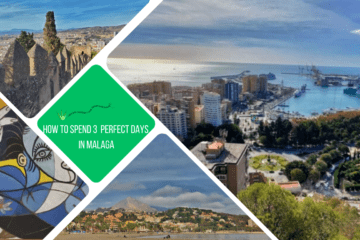
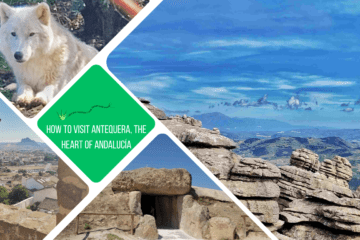
0 Comments